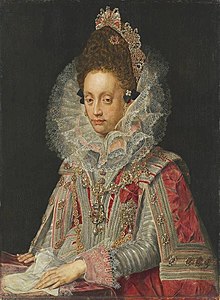Magdalene of Bavaria

Magdalene von Bayern (born July 4, 1587 in Munich , † September 25, 1628 in Neuburg an der Donau ) was a princess of Bavaria and by marriage Countess Palatine of Neuburg and Duchess of Jülich-Berg .
Life
Magdalene was the youngest child of Duke Wilhelm V of Bavaria (1548–1626) from his marriage to Renata (1544–1602), daughter of Duke Franz I of Lorraine .
Habsburg applicants
Archduke Matthias, 30 years his senior, applied for the hand of the princess in 1607 . The initiator of this project was Matthias' advisor Melchior Khlesl , who relied on Bavarian support in the brotherly dispute between Matthias and Emperor Rudolf II . Although Magdalene's father was inclined to this connection, Magdalene's brother Maximilian rejected this plan because he did not want to be drawn into internal Austrian problems. Matthias officially renounced the Bavarian marriage in 1608 after Emperor Rudolf II himself and Archduke Leopold had shown interest in Magdalene.
Archduke Leopold visited Munich in May 1609 and agreed to renounce his spiritual dignity in order to be able to marry Magdalene. To the disadvantage of his brother Matthias, Emperor Rudolf had promised Leopold a succession in Bohemia and Hungary. During this visit Magdalene developed feelings for Leopold and explained that she “had absolutely no affection for Mathias ” and would rather go to the monastery than marry Matthias. Under pressure from his father and brother But Magdalene was finally in 1613 to a marriage of convenience pushing.
Countess Palatine of Neuburg and Duchess of Jülich-Berg
She married the Palatinate Hereditary Prince Wolfgang Wilhelm von Neuburg (1578-1653) on November 11, 1613 in Munich . Magdalene's brother Maximilian was a close friend of the bridegroom and the Bavarian ruling family hoped that the marriage would bring Wolfgang Wilhelm back to the Catholic faith . The wedding ceremony was performed by the Prince-Bishop of Eichstätt Johann Christoph von Westerstetten in the Frauenkirche and the subsequent wedding ceremonies were very lavishly celebrated in the presence of 17 ruling princes. Three days after the marriage, Magdalene renounced any inheritance and succession claims in Bavaria for herself and all of her descendants. Magdalene received 50,000 guilders as marriage goods and her brother also granted her a trousseau of 30,000 guilders.
Magdalene, who was allowed to have two Jesuits in her entourage, a Catholic chapel was set up on the upper floor of the Neuburg Residence. The couple was sent to the "Netherlands" by Count Palatine Philipp Ludwig as governor of Jülich-Kleve-Berg , where disputes arose with the House of Brandenburg over the common inheritance ( Jülich-Klevischer succession dispute ). During a service, Magdalene was shot at through an open window. On May 15, 1614, after assuming the dignity of palatine and duke, Wolfgang Wilhelm, under the influence of his wife, officially converted to the Catholic faith in the main church of St. Lambertus in Düsseldorf . The significant counter-Reformation success justified Magdalenes commitment in the interests of her brother's politics. Despite everything, their marriage is said to have been very happy. Magdalene has been described as very similar to her brother, smart, and politically interested.
Magdalene died unexpectedly at the age of 41 and was buried in the newly built crypt of the Neuburg Jesuit Church.
progeny
From their marriage, Magdalene had a son:
- Philipp Wilhelm (1615–1690), Duke of Neuburg, Duke of Jülich and Berg, Elector of the Palatinate
- ⚭ 1. 1642 Princess Anna Katharina Konstanze of Poland and Sweden (1619–1651)
- ⚭ 2. 1653 Princess Elisabeth Amalia of Hessen-Darmstadt (1635–1709)
literature
- FA Förch: Neuburg and his princes: a historical attempt as a contribution to the history of the principality of Pfalz-Neuburg , A. Prechter, 1860, p. 74 ff.
- Dieter Albrecht: Maximilian I of Bavaria 1573-1651 , Oldenbourg Wissenschaftsverlag, 1998, p. 155 f.
Individual evidence
- ^ Hugo Altmann: The Reich Policy of Maximilian I of Bavaria, 1613-1618 , Oldenbourg Wissenschaftsverlag, 1978, p. 234
| personal data | |
|---|---|
| SURNAME | Magdalene of Bavaria |
| ALTERNATIVE NAMES | Magdalena of Bavaria |
| BRIEF DESCRIPTION | Countess Palatine of Neuburg |
| DATE OF BIRTH | 4th July 1587 |
| PLACE OF BIRTH | Munich |
| DATE OF DEATH | September 25, 1628 |
| Place of death | Neuburg on the Danube |
